Olga Núñez Miret's Blog: Author Translator Olga, page 69
April 14, 2016
#Novedadliteraria Alicia y el teorema de los monos infinitos de Mayte Uceda (@MayteUceda) No pude resistir la intriga del título. Y vosotros?
Hola a todos:
Como sabéis, los viernes os traigo novedades literaria y autores invitados. Mayte Uceda fue invitad mía en mi blog de antes, y hace unos días fue su cumpleaños. Cuando me pasé por Facebook para felicitarla vi que anunciaba su nueva novela con la editorial Planeta. Aún no ha sido publicada, pero no me pude resistir a la portada y el título. Yo no sé a vosotros, pero a mí me ha intrigado mucho….
Primero, algo sobre la escritora:

Autora Mayte Uceda
Mayte Uceda nació en Asturias (norte de España). Es autora de Los Ángeles de La Torre, una novela que ofrece una visión actualizada y diferente del mito del vampiro, y Un amor para Rebeca, una bonita historia de amor situada en Escocia.
Después de pasar unos años en Madrid, regresa a Asturias donde vive con su marido y su hijo en un bonito pueblo marinero, y combina sus quehaceres diarios con la escritura, la música y la pintura.
Sus novelas han ocupado los primeros puestos de sus categorías en el ranking de Amazon-España.
Aquí está su página en Amazon (no os olvidéis de seguirla para enteraros de todas sus novedades):
Y su blog:
Y ahora, el libro que me tiene tan intrigada…

Alicia y el teorema de los monos infinitos de Mayte Uceda
Alicia y el teorema de los monos infinitos de Mayte Uceda
SINOPSIS
Alicia es una joven viuda que dedica sus días al cuidado del viñedo que heredó al fallecer su marido. Tras años de soledad, decide probar suerte en la búsqueda del amor a través de Internet. Después de varias decepciones, irrumpe en su vida Marco, un enigmático y endiabladamente atractivo…
¿¡corso!? Bajo el sol mallorquín, surgirá entre ambos una conexión instantánea y darán rienda suelta a su pasión. Sin embargo, algo no encaja, Marco es demasiado bueno para ser verdad. ¿Qué esconde bajo esa maravillosa fachada? ¿Cómo ha podido fijarse alguien tan perfecto como él en alguien tan corriente como ella? Esas cosas no pasan a los 39 años.
Alicia y el teorema de los monos infinitos es una cautivadora historia de amor manchada por el vino, la pasión, las mentiras, la intriga y el humor más fresco.
En su blog, Mayte nos cuenta un poco más sobre el libro (pero no, no nos cuenta cuál es el teorema ese)
Y os dejo un video por si encontráis alguna pista…
Como os digo, aún no ha sido publicada, pero yo estaré con ojo avizor, desde luego. ¿Y vosotros?
Muchas gracias a Mayte por esta intrigante nueva novela, y mucha suerte, gracias a todos vosotros por leer, y si os ha intrigado, dadle al me gusta, comentad, compartid y haced CLIC!
#Newbook and #bookreview. Demon Road (The Demon Road Trilogy, Book 1) by Derek Landy (@DerekLandy) and Desolation (The Demon Road Trilogy, Book 2). Are you ready for a road trip?
Hi all:
On Fridays I normally bring you new books and/or authors. As I’ve told you I’m in the middle of a bit of a reading and translation spree, and when checking the books I’d read recently I realised that I hadn’t shared the review for one of them (that I’d had my eye on for a while but had resisted so far…) Demon Road by Derek Landy (YA, fantasy, horror…) and these days, the second book in the trilogy was being released, so I thought that was a bit of a strike in two. Review the first book and share the second (that is already waiting in my kindle)…
So, first things first….

Demon Road (The Demon Road Trilogy, Book 1) by Derek Landy
Description:
The epic new thriller begins.
The creator of the number one best-selling Skulduggery Pleasant series returns with the story of a girl on the run from everything she loves…and the monsters that await her.
For anyone who ever thought their parents were monster…Amber Lamont is a normal 16-year-old. Smart but insecure, she spends most of her time online, where she can avoid her beautiful, aloof parents and their weird friends.
But when a shocking encounter reveals a horrifying secret, Amber is forced to go on the run. Killer cars, vampires, undead serial killers and red skinned, horned demons – Amber hurtles from one threat to the next, revealing the terror woven into the very fabric of her life. As her parents close in behind her, Amber’s only chance rests with her fellow travellers, who are not at all what they appear to be….
Witty, action-packed and heart stoppingly thrilling, Demon Road will take you on an epic road trip across the supernatural landscape of America.
Demon Road (The Demon Road Trilogy, Book 1) Kindle Edition by Derek Landy A road trip, a quest and a coming of age story to hell and back
Thanks to Net Galley and to Harper Collins Children’s Books for offering me a free copy of the novel in exchange for an unbiased review.
Demon Road is a coming of age novel of sorts. Amber, the protagonist, is sixteen and discovers that her parents, whom she’s always known weren’t exactly ordinary, are demons and so are their friends, and now she’s started turning too. Worse still, they’re determined to eat her to comply with the terms of a deal they made with the Shining Demon in exchange for power (not that they are particularly sorry about that). With the help of one of her parent’s friends, who’s decided the demonic lifestyle is no longer for her, Amber sets off on a journey to try and save herself by making her own deal. She travels in a car that’s not quite what it seems, with Milo, a bodyguard/chauffer that isn’t what he seems either. The novel follows them in their journey through the different stages of their trip, investigating the many clues, trying to find the one individual who might hold the secret to solving her problem.
Demon Road is also a road trip. The protagonist and her team (Milo and Glen, another character who’s also made a rather stupid deal and has ended up lumbered with a death mark) travel through the Demon Road of the title, a supernatural route linking strange beings, places and happenings, where everybody knows more than they say and people are never who they seem to be. The adventures Amber and her friends/associates (the relationships are open to interpretation) get into are fascinating and varied, going from towns haunted by supernatural serial killers, others with vampires gone out of control, a witch in love in the depths of a forest, winged creatures in New York, and lots of hiding and fighting. Any of the adventures they get involved in would make a great story in its own right and they ensure the plot keeps moving along at a good pace and never gets boring.
Demon Road is a quest. Amber makes a deal which results in her having to look for the only person who’s ever managed to trick the Shining Demon. Every stage of her quest brings her in contact with people, both human and supernatural beings, which have an impact on her and how she sees the world. She also has to come to terms with her new self and not all she learns is positive. As a hero (or heroine) she’s flawed. She can be compassionate and human, and the next minute act on impulse and hurt somebody. She can be quite clever at times and make stupid mistakes at others. She’s easy to anger and lacking in self-confidence but she can be magnificent. She’s not an immediately likeable character although her sense of humour and her capacity for self-reflection make her interesting. Like in all quests, the main character’s search becomes a search for her true self.
Because of all these things, and although the overall pace of the book is reasonably fast, it can feel uneven. It is composed of a number of set pieces interconnected by the trip resulting in a fair amount of telling rather than showing, as they always come upon places or events that have to be explained and grasped, and things slow down at that point and then accelerate when the action comes. Some of those episodes feel more rushed than others (for me the episode with the witch didn’t seem to quite fit in with the time allocated to it, and the bonding between the women and Amber seemed too fast, considering the amount of time they were together. On the other hand I loved the idea and the concept of that story) as if the clock counting down Amber’s time to complete her mission would speed up and slow down. Although it’s true that time is relative and the story is told from a subjective perspective…
The book is written in the third person although it follows Amber’s character and we get her insights and point of view. The writing is dynamic and easy and despite its length, the novel is a quick read.
We have very little information about most of the characters, although that’s in keeping with Amber’s point of view, and it helps us share her feelings, emotions, confusion and attempts at making sense of what’s going on. Milo and his relationship with his car is very intriguing and, at least for me, one of the big successes of the novel. We get some hints of his story but I get the feeling there’s much more to come. Glen might be a divisive one that some readers might love and others hate. I found him at times annoying but at others endearing. Although there are some characters that don’t seem to have any redeeming qualities, most of them are grey rather than black or white, and I thought that added to the complexity of the book and gave it a touch of realism.
There isn’t a love story (at least not so far) and although that might put some readers of the genre off, I didn’t mind so much. The ending is both an ending and it sets off the stage for the next chapter in the story.
In sum this is a novel that packs a lot of stories into a single book, with characters that are interesting if not immediately likeable, and although not perfect, it’s a great read. I’m looking forward to the next book.
Links:
Here if you want to check a preview:
And now, the second book in the trilogy:
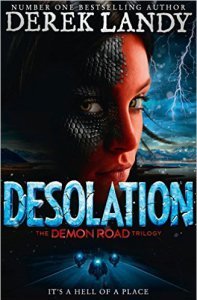
Desolation (The Demon Road Trilogy, Book 2) by Derek Landy
Desolation (The Demon Road Trilogy, Book 2) by Derek Landy
THE EPIC NEW THRILLER CONTINUES.
Book two in the mind-blowing new supernatural thriller from bestselling author DEREK LANDY, creator of international sensation Skulduggery Pleasant.
Reeling from their bloody encounter in New York City at the end of Demon Road, Amber and Milo flee north. On their trail are the Hounds of Hell – five demonic bikers who will stop at nothing to drag their quarries back to their unholy master.
Amber and Milo’s only hope lies within Desolation Hill – a small town with a big secret; a town with a darkness to it, where evil seeps through the very floorboards. Until, on one night every year, it spills over onto the streets and all hell breaks loose.
And that night is coming…
Links:
If you want to have a look:
Thanks to Net Galley, to Harper Collins Children’s Books and to Derek Landy for the books, thanks to you for reading, and you know, if you fancy a trip, like, share, comment and CLICK!
April 11, 2016
#Novedadliteraria y #reseña, más o menos. El reto de Kim Headlee (@KimHeadlee). El verdadero reto es saber por lo que estás luchando
Hola a todos:
Normalmente os traigo nuevos autores y libros los viernes, pero hoy es un poco especial, ya que la historia que os traigo (es cortita) es una que he traducido yo y que me gustó mucho en su versión original. Decidí compartir la reseña que le dediqué a la versión inglesa, traducida, aunque conste que no comento para nada la calidad de mi traducción.
Espero que os guste.
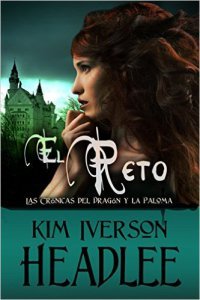
El reto de Kim Iverson Headlee. Traducción: Olga Núñez Miret
El reto. Las crónicas del dragón y la paloma. Kim Iverson Headlee. Traducción Olga Núñez Miret
El guante está echado. Una de las dos debe morir. Rendirse no es una opción.
Arturo el Gran Rey de Breatein está cautivo, presa de su vieja enemiga, Camilla, la princesa guerrera sajona, que ansía vengar la muerte de su prometido a manos de Gyan y que no se detendrá ante nada, ni siquiera la magia negra, para conseguir su objetivo. Gyan y Arturo se han distanciado, y ella teme que Arturo se ponga del lado de Camilla y la nombre su nueva reina.
Para enfrentarse al reto de Camilla, Gyan debe afrontar sus demonios—tanto los públicos como los privados.
Enlace:
http://getBook.at/El_Reto_by_KIH_Kindle
Y aquí mi reseña (del original):
El reto forma parte de Las crónicas del dragón y la paloma de Kim Headlee y aunque esta es la primera historia de la serie que me leo, eso no influyó para nada en mi capacidad de disfrutarla. Es una historia corta que transcurre en el mundo de las leyendas Artúricas y aunque mezcla elementos fantásticos (y no es que no haya elementos fantásticos en la historia que todos conocemos al respecto) también usa como referentes historias y tradiciones más antiguas. Teniendo en cuenta lo corta que es, la historia contiene muchos detalles, no solo sobre la acción y la lucha en sí (con vívidas descripciones de armamento y ropa), sino también sobre las relaciones de la reina, Gyan, con sus hombres, de lo que siente con respecto a su gente y a su reino, pero aún más importante que todo eso, la reina tiene que enfrentarse a sus dudas sobre su relación con el rey. Y aunque no voy a daros muchas pistas, puedo deciros que el final no os defraudará.
Si estáis buscando una lectura corta, llena de acción, con una buena mezcla de detalles históricos y fantasía, y con una fabulosa protagonista, os la recomiendo.
Y si queréis echarle un vistazo…
Y como Kim Headlee también tiene otra historia corta de la misma serie disponible en español, no me pude resistir. Espero leérmela dentro de poco, así que os traeré un comentario también.

El color de la venganza de Kim Headlee. Traducción O. Gary
El Color de la Venganza (Las Crónicas del Dragón y la Paloma) (Spanish Edition) Kim Headlee. Traducción: O. Gary
El Color de la Venganza “esta historia de amor, coraje y venganza está escrita brillantemente por Kim Headlee, una autora experta en leyendas Artúricas.” ~ David del blog Crónicas Creativas.
Cuando los ladrones de ganado Angli matan a su esposa e hijo, Dwras hijo de Gwyn jura vengarse de sus asesinos. Pero, ¿cómo puede un simple granjero prevalecer contra bien entrenados y despiadados guerreros? Dwras no debe buscar la respuesta en su espada, sino en su corazón.
Enlace:
http://getBook.at/El_Color_de_la_Venganza_by_KIH_Kindle
Mucha gracias a Kim Headlee for ofrecerme la oportunidad de traducir su novela, gracias a todos por leer, y si os ha interesado, dadle al me gusta, comentad, compartid, y haced CLIC!
#Bookreview #RBRT Flesh by Dylan J. Morgan (@dylanjmorgan) Horror, twists and turns and a small-town legend that’s anything but… #Tuesdaybookblog
Hi all:
I already told you last week I was reading a lot these days, and today I bring you another review, this one of a book I read as part of Rosie’s Book Review Team. It’s a great privilege to form part of such wonderful team of people. And today, I bring you a scary one…

Flesh by Dylan J. Morgan
First, the description:
It feeds. It grows. The small town of Vacant harbors a secret so terrifying that the local lawmen will do anything to keep it hidden—including murder. Something sinister stalks the surrounding woods, a horrifying creature thought to be only a mystical legend. It hunts at night, killing with ravenous voracity. Deputies Carson Manning and Kyle Brady are the harvesters: they find the victims, tie them to the baiting post. Sheriff Andrew Keller and Deputy Matthew Nielsen are the cleaners: they dispose of the corpses. But when Vacant’s townsfolk take matters into their own hands, nothing can contain the slaughter. The deadly entity isn’t the only menace Sheriff Keller has to face. He has his own dark secret, a past he tries to hide behind frequent alcohol binges. Now that past has come back to haunt him and will throw him headlong into a traumatic situation that could mean life or death for him and those he holds dear.
And now, my review:
Flesh by Dylan J. Morgan Horror, twists and turns and a small-town legend that’s anything but…
I am reviewing Flesh as part of Rosie’s Book Review Team and I’ve received a complimentary copy of the novel in exchange for an unbiased review.
I love horror. Books, movies, series… I’d read very good reviews of Dylan J. Morgan’s books and when I saw one of his books come up for review at Rosie’s team I decided to take the chance and read it.
You probably have read (and/or watched, if you’re interested in the genre) similar stories. Small town, something in the woods is killing people. The something might vary from book to book. Here the small town is not the wholesome small-town of cosy diners and picket fences, but rather the strange world of Blue Velvet (well, perhaps weird in a different way, a corrupt place full of drug-addicts, alcoholics, mad preachers, power-crazy mayors, and people prepared to do anything to keep themselves safe, even if it means others have to suffer). And the story is written in such a way that we don’t really know what we think we know, or rather, we don’t realise what we know until very close to the end. At least for me, the novel was full of surprises.
The novel is told in the third person, from quite a few of the characters’ points of view, the main characters. None of them, with the exception of Miranda, but she hardly appears in the first part of the book, are easy to connect with or sympathetic. The book opens with one of the character’s (although we are not told many things about her) extreme violence and a description of butchery that, being a doctor, I must confess had me wondering if some of the things were anatomically possible… As we see things from the character’s mind’s eye, the reading can be quite uncomfortable. On the other hand, at least for me, it didn’t work at the level of some scenes of extreme violence in Tarantino’s movies, for instance, when you might find yourself joining in and siding with the perpetrator. But perhaps that’s a matter of personal taste. The rest of the main characters are deeply flawed, addicted to alcohol, drugs, and egotistical. Matthew, newly joined deputy sheriff seems too good to be true, other than for his sexual relationship with a woman that also seems to break the rules (sex during work at the police station for instance), but until more than fifty per cent of the book has gone we don’t have much of a hero to root for. And then, things change. And how. (Also some new characters appear that add to the interest, but the biggest surprise is how the ones we knew already change. Or we realise we didn’t know them quite as well as we thought.)
I’m not overtly fond of descriptions and the book is full of them, be how the characters are feeling (hangover, highs of drugs, sex, hot and sweaty…), clothes, food, drinks… Although well-written, I felt due to this the first half of the novel moves at a slow-steady pace, whilst the last half speeds up.
As you’ve probably noticed from what I’ve said, I thoroughly enjoyed the second half of the book, where you feel much more invested and engaged with the characters and things get much more personal, not only for us but for some of the protagonists. It is a good way of rising expectations and interest, although there is always the risk that some readers might not follow the writer, but in this case it’s well-worth the patience. I won’t go into a lot of detail not to spoil the reading experience, but as I mentioned, it took me quite a while to work out the connections and the ins and outs of the plot. It’s very cleverly done.
Overall, would I recommend this book? Yes, if you love horror, and you like descriptive writing, both of horrific scenes and in general (there’s also a fairly explicit sex scene, be warned), and want to be taken by surprise (even shocked). And, a word of warning, whatever you think of the beginning, keep reading, because the second half of the book is fantastic.
Link:
If you want to check directly the preview, here it is:
Thanks so much to Rosie and to the author for this opportunity, thanks to you all for reading, and don’t forget to like, share, comment, CLICK, and of course, to REVIEW!
April 7, 2016
#Autorinvitadoclásico. Emilia Pardo Bazán. Naturalismo y Realismo en la literatura española
Hola a todos:
Como ando liada leyendo novela histórica, decidí compartir hoy uno de los posts de mi antiguo blog, dedicado a una gran escritora y a una mujer fascinante: Emilia Pardo Bazán.
Como la mayoría de los viernes, os traigo una escritora clásica. Hoy es a sugerencia de Xan, uno de los miembros del grupo Café Literario en Goodreads, que comentó sobre uno de mis previos posts (el de Rosalía de Castro), y aquí os la traigo porque me pareció una sugerencia fabulosa, y porque quería aprender más sobre ella. Emilia Pardo Bazán.
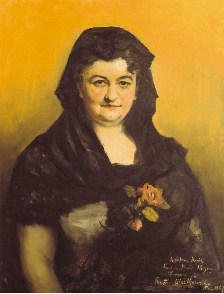
Emilia Pardo Bazán (Photo credit: Wikipedia)
Como suelo, primero os presento una breve biografía (más abajo os dejo enlaces donde podéis encontrar más detalles) y luego enlaces gratuitos a sus obras.
Biografía:
Emilia Pardo Bazán nació en La Coruña el 16 de Septiembre de 1851, de familia aristocrática gallega (su padre era Conde y ella heredó el título a su muerte). Su padre era un político liberal y la familia se aseguró de que Pardo Bazán tuviera una muy buena educación y fomentaron su interés por la literatura. Desde los 9 años empezó a escribir. La familia tenía varias residencias, una en un pueblo de pescadores cerca de Sanjenjo y una en las afueras de La Coruña, el Pazo de Meirás. Leyó mucho y comentaba que sus obras favoritas de juventud fueron Don Quijote, la Biblia y la Ilíada. La familia iba a Madrid durante los inviernos, donde ella acudió a un colegio francés, y Pardo Bazán aprendió francés y empezó a leer muchos de los clásicos franceses. Ella se negó a seguir los dictados de la educación de señoritas de buena familia y se negó a aprender el piano o a estudiar música, dedicando todo el tiempo que podía a leer.
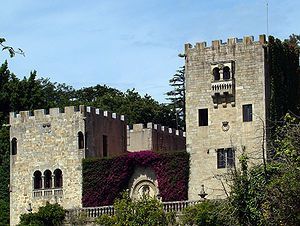
gl:Pazo de Meirás – – Sada – A Coruña (Photo credit: Wikipedia)
A los 17 años se casó con José Quiroga Pérez Deza, que se dedicaba a la política. Se trasladaron a Madrid, y cuando fue elegido diputado el resto de la familia se les unió. Cuando se desilusionó de la política la familia se fue de viaje, primero a Francia y luego por toda Europa (Inglaterra, Italia, Alemania) donde Pardo Bazán aprendió también el alemán y el inglés. Publicó crónicas del viaje y más tarde libros, proponiendo que era necesario europeizar España y sugiriendo viajar como medio de educación.
Ganó un premio en competición directa con Concepción Arenal con Estudio crítico de las obras del padre Feijoo (1876). En el mismo año nace su primer hijo al que le dedica un libro de poemas Jaime. En 1879, el año en que nació su hija Blanca, publicó su primera novela, Pascual López (autobiografía ficticia de un estudiante de medicina… tendría que leerla yo). Tuvo éxito y la llevó a seguir escribiendo, aunque aún no había desarrollado el estilo que la haría conocida.
En 1882 empezó a publicar en la revista La Época una serie de artículos sobre Zola que luego fueron reunidos en La cuestión palpitante (1883) que la hizo ganar la reputación de impulsora del naturalismo en España. La obra trajo mucha controversia ya que se vio como una obra a favor de la pornografía francesa y de la literatura atea, aún más grave al ser mujer. Su marido insistió en que dejara de escribir y se retractara públicamente pero ella no lo hizo y se separó de su marido al año siguiente. En 1884 publicó La dama joven sobre crisis matrimoniales. Empezó una relación amorosa con Benito Pérez Galdós (que se merece un post propio, desde luego) que duraría más de veinte años. (Por lo que leo por lo visto ella tuvo otros amoríos con jóvenes escritores como Narcís Oller). Su estilo de naturalismo, al igual que el de Galdós tenía características típicamente españolas, incluyendo el catolicismo (que nunca abandonó), y es más conservadora, aunque admite los principios del determinismo social y darwinismo. Su obra maestra es Los pazos de Ulloa.

Benito Pérez Galdós, by Joaquín Sorolla (Photo credit: Wikipedia)
Su obra de ensayos y periodismo incluye su lucha por la emancipación de la mujer, escribiendo artículos y dando conferencias sobre el tema. Su posición le ganó enemistades de otros escritores (hombres)… Suena a envidia, de verdad.
Su obra se volvió mas simbolista y espiritual cuando murió su padre (Una cristiana, La prueba, La quimera). Escribió muchos cuentos y creó una revista El Nuevo Teatro Crítico.
En 1892 funda y dirige la publicación de La Biblioteca de la mujer. Denuncia la desigualdad en la educación de las mujeres. Como exponente de ello su propuesta de Concepción Arenal a la Real Academia de la Lengua es rechazada (tampoco aceptaron a Gertrudis Gómez de Avellaneda ni a Pardo Bazán que fue nominada 3 veces). En 1906 fue la primera mujer presidente de la sección de literatura del Ateneo de Madrid, y la primera que ocupó la cátedra de literaturas neolatinas en la Universidad Central de Madrid, aunque solo un estudiante acudió a clase.
También escribió obras de teatro, libros de viajes, biografías…Más recientemente publicaron su primera novela (escrita cuando tenía 13 años) Aficiones peligrosas y descubrieron una novela inédita, Selva.
Murió en Madrid el 12 de Mayo de 1921, de una gripe que complicó su diabetes.
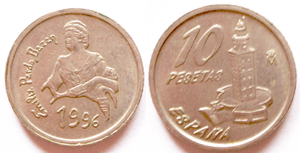
10 pesetas 1996 emilia pardo bazan (Photo credit: Wikipedia)
(Aquí podéis observar la devaluación de la moneda y quizás el sexismo (?). A Gustavo Adolfo Bécquer le dedicaron un billete de 100 pesetas. A Emilia Pardo Bazán una moneda de 10 pesetas).
Enlaces:
Biografía e información:
Wikipedia:
http://es.wikipedia.org/wiki/Emilia_Pardo_Baz%C3%A1n
Su portal en la Biblioteca virtual Cervantes:
http://www.cervantesvirtual.com/portales/pardo_bazan/
Biografías y vidas:
http://www.biografiasyvidas.com/biografia/p/pardo_bazan.htm
Escritores.org:
https://www.escritores.org/biografias/451-emilia-pardo-bazan
Un documental de RTVE (2009) sobre Emilia Pardo Bazán:
La casa-museo de Emilia Pardo Bazán (que contiene la sede de la Real Academia de la Lengua Gallega):
http://www.museosdeescritores.com/ESP_II/autor/pardobazan.htm
Y la casa-museo en Galego:
http://www.casamuseoemiliapardobazan.org/
Por lo visto van a digitalizar algunas de sus obras, por fin:
Swarthmore:
http://www.swarthmore.edu/Humanities/mguardi1/espanol_11/pardobazan.htm
Video sobre su vida y obra literaria en You Tube:
http://www.youtube.com/watch?v=SYTxkI0wk3k
Enlaces gratuitos a su obra:
Su catálogo en la biblioteca Cervantes (Incluye Los pazos de Ulloa editado por Ana María Freire):
http://www.cervantesvirtual.com/portales/pardo_bazan/catalogo/
He encontrado muchas de sus obras gratis en Amazon, pero no estoy segura de que se puedan obtener en todas las tiendas (en .com, co.uk y .es sí, pero por probar)…Si queréis ir a vuestra tienda solo hace falta cambiar .com por el sufijo correspondiente (.es para España, .mx para México…)
Os dejo unas cuantas:
Reconciliados:
Cuentos de Navidad y Año Nuevo (por la época del año):
Cuentos del terruño:
Historias y cuentos de Galicia:
Los pazos de Ulloa:
Un viaje de novios:
Hay algunas obras de las que parece que existan varias versiones en Amazon…
24 Symbols también ofrece sus obras en lectura gratuita en el Internet:
http://www.24symbols.com/author/emilia-pardo-bazan?id=64
Obras completas en varios formatos:
https://archive.org/details/obrascompletas03pard
Este es el enlace a la serie de Los pazos de Ulloa (que recuerdo bien) en IMDB. Por lo visto está a la venta en Amazon, pero supongo que también estará disponible en otros sitios.
http://www.imdb.com/title/tt0089787/?ref_=nm_flmg_wr_1
Gracias por la sugerencia a Xan, por leer a todos, y si os ha gustado, acordaos de dadle al me gusta, comentad, compartid, y haced CLIC (¡que es gratis!) Y por cierto si tenéis más sugerencias…soy toda oídos.
#Guestclassicauthor Sir Walter Scott. Scotland, History, Legend and Everything in Between.
Hi all:
As I told you on Tuesday, I’m helping in the selection process of a Historical Novel Award (the M.M. Bennetts Award) and I thought that gave me the perfect opportunity to share one of the posts I had dedicated in my previous blog to a writer who fits nicely in the genre. Sir Walter Scott.

Trossachs. Sir Walter Scott based his ‘the Lady of the Lake’ on this area.
It is Friday and it’s guest author day. I seemed to have to write about Sir Walter Scott as he kept appearing everywhere. When I was writing last week’s post on Frederick Douglass, he chose his free-man name by adopting that of one of the characters in Sir Walter Scott’s ‘Lady of the Lake’. I was writing about Jorge Manrique, who was a Spanish knight and poet, and that made me think about knights, novels… and Sir Walter Scott. And today somebody mentioned Robbie Burns on the radio, and that made me think of Scotland and… So here he is.

Henry Raeburn’s portrait of Sir Walter Scott and his dogs
Sir Walter Scott (he was knighted by George the IV and became First Baronet) was born on the 15th of August 1771. His father was a successful solicitor and his grandfather (on his mother’s side, John Rutherford), had been Professor of Physiology at the University of Edinburgh. He contracted poliomyelitis when he was only a few months old and spent plenty of time at his grandparents’ farm in the Scottish Borders, (Tweeddale) where he showed an interest in history and the local customs.
He attended the Edinburgh High School and then with his father’s encouragement studied law at Edinburgh University (although according to one source he never took the degree exams as he only wanted to become an advocate, but passed the bar exam in 1792). Although he persevered with the legal job, he started writing poetry when he was 25 (he initially translated German poems and works). In 1797 he married Charlotte Carpenter, the daughter of a French refugee. They were happily married until her death (in 1826). They had four children. Their first born died when he was only one day old. In 1803 he published a three-volume set of collected Scottish ballads, The Minstrelsy of the Scottish Borders. This was followed by many narrative poems that became extremely popular, like The Lay of the Last Minstrel (1805), Marmion (1808), The Lady of the Lake (1810), Rokeby (1813) and The Lord of the Isles (1815). His depictions of the Scottish landscape, stories and customs helped to put Scotland on the radar and it became a touristic destination, fueling a fashion for all Scottish things.
He became Sheriff-Depute of Selkirk and a Principal Clerk to the Court of Session at Edinburgh. He continued to publish his own poems, reviewed, edited, set up a theatre in Edinburgh and helped fund the Quarterly Review in 1809.
Despite his great fame as poet (he declined the Poet Laureate in 1813 suggesting Robert Southey for the post) it would be his novels that would make him reach new heights in esteem and popularity. He published (anonymously) Waverley in 1814 (subtitled Sixty Years Since). This novel has been credited with creating the genre of the historical novel. Other novels dealing also with the Highlands and Jacobitism and forming part of what has become known as ‘the Waverley novels’ are Rob Roy (1817), The Heart of Midlothian (1818) and Redgauntlet (1824).
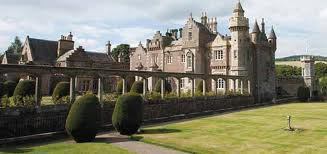
Sir Walter Scott’s home ‘Abbotsford’
He associated with Ballantyne’s in his publishing company, and was badly affected by the bank crisis of 1825 (yes, this is not a new thing). He also had difficulties due to the financing of the built of his home at Abottsford. I have read variously that the debt amounted to between £114000 to £140000 (a fortune at the time). Rather than declare himself bankrupt, he placed his home and income into a trust belonging to his creditors and carried on writing his way out of his debts. He suffered a series of strokes and died on 21st September 1832. It seems that he had not fully paid his debt at the time but with the royalties from his books this was settled shortly after his death. He was buried at Dryburgh Abbey with his ancestors.
Some of his other novels include: Ivanhoe (set in England, 1819, probably the best known of them all), The Bride of Lammermmoor (also in 1819), Kenilworth (1821), The Fortunes Of Nigel (1822), Peveril Of The Peak (1823), Quentin Durward (1823), The Talisman (1825), Woodstock (1826), The Surgeon’s Daughter (1827), and Anne Of Geierstein (1829).
Sir Walter Scott was also one of the first authors to become internationally renowned and admired in other countries, and he toured often.
He was not only prolific, hard-working and principled, but very modest. I loved this comment that I felt I had to share:
While on holiday in Shetland he wrote:
…it would be a fine situation to compose an ode to the Genius of Sumburgh-head,
or an Elegy upon a Cormorant – or to have written or spoken madness of any kind
in prose or poetry. But I gave vent to my excited feelings in a more simple way;
and sitting gentle down on the steep green slope which led to the beach, I e’en
slid down a few hundred feet, and found the exercise quite an adequate vent to
my enthusiasm, I recommend this exercise (time and place suiting) to all my brother
scribblers, and I have no doubt it will save much effusion of Christian ink.
(I must thank Stuart Kelly at the Scottish Poetry Library for sharing it in his page. Link below)
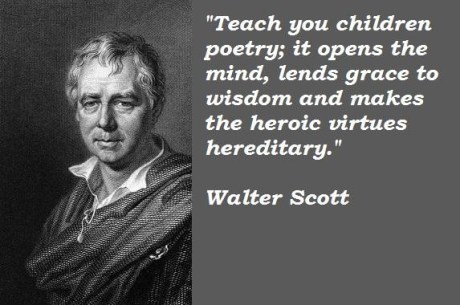
Sir Walter Scott on poetry
Links:
Biography:
Wikipedia:
http://en.wikipedia.org/wiki/Walter_Scott
His digital archive at the University of Edinburgh.
http://www.walterscott.lib.ed.ac.uk/
BBC2. Writing Scotland:
http://www.bbc.co.uk/programmes/p00mr8yj/profiles/walter-scott
Website for Abbotsford, his home:
http://www.scottsabbotsford.com/
Encyclopaedia Britannica:
http://www.britannica.com/EBchecked/topic/529629/Sir-Walter-Scott-1st-Baronet
His page at the Scottish Poetry Library:
http://www.scottishpoetrylibrary.org.uk/poetry/poets/sir-walter-scott
SpartacusSchool net:
http://www.spartacus.schoolnet.co.uk/Jscott.htm
The Literature network:
http://www.online-literature.com/walter_scott/
Works:
His books in Amazon.co.uk (there a few free versions and many cheap ones):
And in Amazon.com:
This is his author page at the Project Gutenberg where you can find and download free e-books:
http://www.gutenberg.org/ebooks/author/59
Some of the above links, like his digital archive, contain also online links to his works.
Images:
The header is from:
http://infinite-scotland.com/poi/sir-walter-scott/
And the quote above came from:
http://bhuwanchand.wordpress.com/2013/09/17/dailybookquote-17sep13-sir-walter-scotts-ivanhoe/
For more pictures and information about his home:
http://exploretheborders.com/sir-walter-scott-and-abbotsford/
And I leave you also an article quoting Stuart Kelly talking about Sir Walter Scott’s importance:
http://www.theguardian.com/books/2010/aug/16/walter-scott-edinburgh-book-festival
Thanks for reading, I hope you’ve enjoyed it and if you have, please remember to like, share, comment and CLICK! Never stop reading!
April 4, 2016
#Blog y las tareas que nunca se acaban

Otra fabulosa imagen de Unsplash.com
Hola a todos:
Hoy solo os quería comentar que no os preocupéis demasiado si veis que mi blog es algo irregular en cuanto a contenidos en las próximas semanas. Aparte de seguir tan ocupada como siempre, tengo un par de cosas ahora mismo… Gracias a uno de los grupos donde hago reseñas (hola Rosie) me ofrecí a leer algunos de los títulos para ayudar en la preselección de un premio de novela histórica, el M. M. Bennetts Award y ahora ha llegado a la siguiente fase, así que me han pedido que les siga ayudando. Y como me pareció una gran oportunidad para ver cómo funcionan este tipo de cosas desde dentro (y nunca me hacen falta demasiadas excusas para leer libros interesantes) estaré muy ocupada leyendo estas semanas que vienen. (Paciencia también a los libros que tengo pendientes…) Además, estaré preparándome para participar en mi primera feria de libros, en Llandeillo, Gales. El evento, organizado por un gran autor que apoya muchísimo a los autores indies, Christoph Fischer, será el 30 de Abril. Aquí él os da todos los detalles.
Así que entre una cosa y otra, me quedará aún menos tiempo del habitual, pero intentaré aprovechar para compartir algunos de los posts de mi antiguo blog que no sobrevivieron al traslado, quizás comparta algo más de mi nuevo libro, y ya veremos….
Gracias por vuestra paciencia, gracias por leer, y ya sabéis, dadle al me gusta, comentad, compartid, y haced CLIC!
#Bookreview Three books by women for everybody @SarahMallery1 @KimHeadlee and @sgc58 #TuesdayBookBlog
Hi all:
I anticipate I’m going to have a few incredibly busy reading weeks ahead (I’m helping with the selection process for the Historical Fiction M. M. Bennetts Award) and I’m also going to be busy preparing for my first book fair (check the post by fabulous author Christoph Fischer who explains everything about the Llandeillo Book Fair here and you can also visit the Facebook page of the event) so I’m not sure what my blog is going to be like (as I had promised I’d be recovering some of the old posts from my previous WordPress site that didn’t manage to survive the move, there will be some of that for sure) but I count on your patience and support as usual. I might share a bit more of my WIP (while I try to work out what the cover should look like. Thanks for the suggestions!), share some reviews as far as I can (I don’t want to disrupt the award process, although I’ll let you know the results), keep looking for ideas and feedback on my non-fiction project… We shall see.
But, as I’ve accumulated a few reviews I thought that would make an interesting post. The three authors I bring you today have visited my blog before. They are women of substance, who blog, research, help their fellow authors, and write wonderfully, and although I’m sure you know them all, if you don’t, for their works you’ll know them…
Enough blah, blah. Here they come:

The Dolan Girls by S. R. Mallery
The Dolan Girls by S. R. Mallery.
Description:
Set in Nebraska during the 1800s, whorehouse madams, ladies of the night, a schoolmarm, a Pinkerton detective, a Shakespeare-quoting old coot, brutal outlaws, and a horse-wrangler fill out the cast of characters. Add to the mix are colorful descriptions of an 1856 land rush, Buffalo Bill and his Wild West Show, Annie Oakley, bank/train robberies, small town local politics, and of course, romance. Two, in fact!
Body of review:
I was given a free copy of the novel in exchange for an honest review.
I’ve read two of S. R. Mallery’s books before and I’ve always admired her ease in creating stories emotionally real and characters we care for set in historical eras and around historical events that add dimension and depth to the narration. Most of her stories centre on female protagonists and we experience through them the travails and challenges these women had to face in different times in history, be it because of their class, race, gender, profession or their situation.
Cora and Minnie, the young girls arrived from Ireland with their parents, who plan to get some land in Nebraska but fail, end up alone and living in a brothel after tragedy strikes. Madam Ana treats them like her daughters and the brothel becomes their home and later their business. Cora’s love story is ruined by a terrible event, a baddie with no redeeming qualities (Wes’) rapes her and impregnates her, and she doesn’t trust men again. She focuses her life on the business and her family, and wants to ensure that her daughter will be respected and safe, even against her wishes.
The three Dolan girls, Cora, Minnie and Ellie embody different models of womanhood: Cora worries about society’s views and being respected, and is straight-laced and serious. Minnie is free, unconventional and only worries about doing what’s right and fun, no matter what anybody else might think. Ellie loves education, learning, and is passionate about enlightening the population and not taking no for an answer. Despite their differences, they all have in common their strength, their perseverance, and their determination to live life their own way, no matter what polite society might think.
Annie Oakley, Buffalo Bill and Lola Montez make significant appearances and add to the historical interest but their appearance is not an exercise in hero worshiping. The author blends beautifully historical detail, language and décor without dumping information or appearing to quote from a textbook.
The bandits’ train-raid and later arrival at South Benton, Buffalo Bill’s first show, and the Pinkerton detective agency and their work add a good dose of adventure and make it a page turner even for people who wouldn’t consider reading a standard romantic novel.
The male protagonists are heroic but understanding and not overbearing. Their behaviour seemed to me somewhat idealised but well within the conventions of the genre.
The Dolan Girls shows us that winning the West wasn’t only a man’s endeavour, that not all immigrants were the same (Irish not being welcome with open arms), that gender violence is not new, and that women can be strong together.
In sum, a great read and a must for people who love historical romances. Ah, and don’t worry about the ending. You’ll love it!
Links:
And if you want to check a preview:
Next:
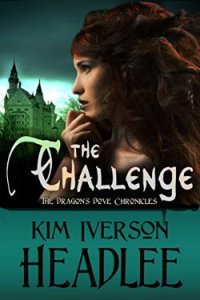
The Challenge by Kim Iverson Headlee
The Challenge (The Dragon’s Dove Chronicles) by Kim Iverson Headlee. The real challenge is to know what you’re fighting for.
Description
The gauntlet is thrown. One must die. Refusal is not an option.
Arthur the high king of Breatein has fallen captive of a longtime enemy, the Saxon warrior-princess, Camilla, who lusts to avenge the death of her betrothed at Gyan’s hands and will stop at nothing, even the black arts, to achieve her goal. Because Gyan and Arthur have grown estranged, she fears that Arthur may side with Camilla and make her his new queen.
Now Gyan must face all her demons – public as well as private.
My review
The Challenge is a part of Kim Headlee’s The Dragon’s Dove Chronicles and although it is the first story of the series I’ve read, that does not impede its enjoyment. It is a short story set in the world of the Arthurian legends and although it mixes fantasy elements (not that there are no fantasy elements in the story we’re all familiar with) it does refer back to older stories and traditions. Considering its length, the story packs an incredible amount of detail, not only of the action and fight itself (with vivid descriptions of weapons and gear), but also of the relationships of the queen, Gyan, with her men, of her feelings about her people and her kingdom, and also of her mental state at the time. She confronts a rival with supernatural strength, but more important than that she also has to fight her doubts about her relationship with the King. And although I’m not going to give you any spoilers, I can tell you that the ending won’t disappoint.
If you fancy a short read, full of action, with a good mix of historical detail and fantasy, and a superb strong female lead, I strongly recommend it.
Links:
And the preview:
At the moment of preparing this post it’s FREE so check it out!
And last by not least…

Tales from the Garden by Sally Cronin
Tales from the Garden by Sally Cronin. Enchanting stories in a magical garden
Tales from the Garden reveals the secrets that are hidden beneath hedges and trees. You will discover what really happens at night as you sleep unaware in your bed. Stone statues and those hidden worlds within the earth are about to share their stories. The guardians who have kept the sanctuary safe for over fifty years will allow you to peek behind the scenes of this magical place. They will take you on a journey through time and expand your horizons as they transport you to the land of fairies, butterflies and lost souls who have found a home here.
Fairy Stories for children of all ages from five to ninety-five that will change the way you look at your garden forever.
My review:
I received a free copy of this book in exchange for an unbiased review.
I follow Sally Cronin’s Smorgasboard blog and know she writes on a variety of themes, from the non-fictional: nutritional and health advice, features and reviews about books and writing, advice on marketing and blogging, and also fictional writing. After reading some of the stories she had shared on-line I had to read this book. And the description is correct. These are fairy stories for children of all ages. The characters are the stone sculptures in the garden and their adventures contain in equal parts warmth, pathos, magic and fantasy. We have animals escaping from hunting dogs, impossible love stories between humans and fairies, orchestras made up of the most varied characters, and a wonderful dedication to the author’s mother and her gardens. You will go through a variety of emotions and always feel better and more positive by the end of each story. The book will leave you smiling and that’s something that cannot be said of many books (or things) these days.
The writing is fluid, perfectly suited to the themes and you get the sense that you’ve been taken into the confidence of the characters and have become an honorary inhabitant of this wonderful garden. The pictures —all from the author and her family’s gardens— that illustrate the book help make the reader feel even more at home.
Recommended to any readers who need a bit of magic and wonder in their lives.
Links:
The preview:
Sally, who has a blog everybody should follow, no matter what your interest, also has her own publishing company and you might want to access this and her other books directly. Just in case, this is the link to her books in her blog.
Thanks to the three authors for their varied and fantastic books, thanks to all of you for reading and don’t forget to like, share, comment, CLICK, and of course, if you read, REVIEW!
March 31, 2016
#Novedad Literaria Los últimos españoles de Mauthausen de Carlos Hernández de Miguel (@demiguelch). Porque ciertas cosas no se deben olvidar
Hola a todos:
Como sabéis los viernes os traigo novedades literarias. Encontré el libro de Carlos Hernández de Miguel Los últimos españoles de Mauthausen en una nueva página de Facebook, Libretería, que muestra a autores presentando sus propios libros y como los que me seguís hace cierto tiempo sabréis, el tema de los españoles en campos de concentración me interesa por motivos familiares (un tío de mi madre murió en Mauthausen y he compartido posts sobre el tema en mi otro blog, y espero compartir algunos en este blog) así que me pareció motivo más que sobrado para traéroslo.
Primero, algo sobre el autor:

Autor Carlos Hernández de Miguel
Carlos Hernández de Miguel es periodista y experto en comunicación empresarial y política. Licenciado en Ciencias de la Información por la Universidad Complutense de Madrid, inició su carrera profesional en Antena 3 Televisión como cronista parlamentario en el Congreso de los Diputados. Posteriormente ejerció de corresponsal de guerra en diversos conflictos internacionales, como Kosovo, Palestina, Afganistán o Iraq.
En los últimos años ha ocupado los puestos de redactor jefe del semanario La Clave, director de comunicación del PSOE y asesor de imagen en diversas empresas. En la actualidad colabora con publicaciones y diarios digitales como El Mundo y la revistaViajar.
Premio Víctor de la Serna al mejor periodista del año 2003, concedido por la Asociación de la Prensa de Madrid. Premio Ortega y Gasset de periodismo concedido a los enviados especiales a Iraq como mejor cobertura informativa del año 2003.
http://www.edicionesb.com/catalogo/autor/carlos-hernandez-de-miguel_1236.html
Y aquí, su libro:

Los últimos españoles de Mauthausen de Carlos Hernández de Miguel
Los últimos españoles de Mauthausen de Carlos Hernández de Miguel (Author), B de Books (Editor)
La historia de nuestros deportados, sus verdugos y sus cómplices.
Un libro único cuando se cumple el setenta aniversario de la liberación de los campos nazis.
«Tenía que intentar contar nueve mil historias, una por cada uno de los españoles y españolas que pasaron por los campos de concentración nazis. Sentía la necesidad de reflejar sus anhelos, viajar con ellos en esos fatídicos trenes de la muerte, acercarme a su sufrimiento en los campos, a la solidaridad en que se apoyaron para tratar de sobrevivir, a su alegría durante la liberación y a su frustración ante la imposibilidad de volver a su patria. Para ello visité a los pocos supervivientes que aún pueden hablar en primera persona. Conocerles ha sido uno de los mayores privilegios que me ha dado la vida.
No es un libro fácil, nunca pretendió serlo, pero espero que resulte útil ya que la historia de nuestros deportados no tiene fecha de caducidad. La intolerancia, el racismo, el populismo, las traiciones que sufrieron, los pactos que hicieron sus verdugos, la pasividad de «los hombres buenos»… casi todo lo ocurrido se puede extrapolar hasta nuestros días. En este caso, quizás más que en ningún otro, mirar hacia el pasado es la mejor forma de comprender el presente y de prever nuestro futuro.» Carlos Hernández de Miguel
En este libro se habla de víctimas y de verdugos. Los últimos españoles supervivientes de los campos de exterminio nazis nos recuerdan su sufrimiento y la forma en que perdieron a miles de compañeros a manos de los siniestros miembros de las SS. Sus palabras nos llevan a un mundo de torturas inimaginables, pero también de dignidad, solidaridad y resistencia.
Esta es la historia de esos hombres y mujeres que sobrevivieron o murieron entre las alambradas de Mauthausen, Buchenwald, Ravensbrück o Dachau. Y es también la crónica periodística que denuncia a los políticos, militares, empresarios y naciones que hicieron posible que más de nueve mil españoles fueran deportados a los campos de la muerte.
Si queréis leer algo más sobre el libro, incluyendo una entrevista con el autor, os dejo un par de enlaces:
Muchas gracias a Carlos Hernández de Miguel por su libro, gracias a todos vosotros por leer y si os ha interesado, dadle al me gusta, comentad, compartid y haced CLIC
#Mother’sDayBlogTour Today Daisy Banks (@DaisyBanks16). December Roses dedicated to our parent’s support
Hi all:
Those who follow me might remember that a few weeks back I shared a post about a collection of books for Mother’s Day, Mother’s Day Magic, and information about one of the authors who’d kindly offered me the opportunity to share not only the collection but also interviews with several of the authors. Tamara Ferguson, a fantastic author and a great supported of fellow indie writers, was featured in the first post, here.
Today, I have the pleasure to remind you about that great collection and to introduce you to Daisy Banks, one of the UK authors taking part in the collection.
Ah, and don’t forget that 10% of the proceeds will go to the National Multiple Sclerosis Society Towards Research.
And without any more blah, blah, here it goes:
Mother’s day Magic…
with love
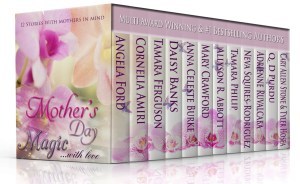
Every mother’s heart holds a bit of magic…her children’s love. Enchantment awaits in a dozen brand new, previously unpublished-stories, written by #1 bestselling and/or multi-award winning authors from across the globe. Whether it’s a captivating tale of romance or fiction fashioned from loving memories, these poignant stories are sure to touch your heart.
10% of proceeds from this anthology will go to the National Multiple Sclerosis Society toward research.
Amazon
nook
Kobo
Itunes
24symbols
Scribed
Inktera (formally Page Foundry)
Tolino
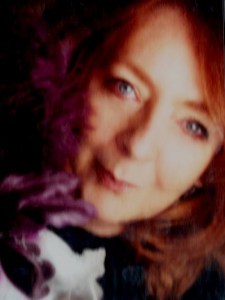
Author Daisy Banks
AN INTERVIEW WITH Daisy Banks One of the Authors FROM MOTHER’S DAY MAGIC
The Story I’ve Contributed Is

December Roses by Daisy Banks
December Roses
A present-day gift of flowers sets off delightful memories for Jean. The recollections of the day love first bloomed and trust overcame a frightening challenge are carved deep in her heart.
What Was The Inspiration For Your Mother’s Day Magic Story?
My story is based on the true experience of my mother and her recollections of the day she and my father took their first important step closer to marriage. The magic is that I have been given the time to collect her memories and put them into a story for others to read.
How much research was involved in writing your story? How did you go about it?
My research has been through conversations with my mother, as she is in her eighties and rather frail these talks have had to fit into her daily routine as much as possible. I have found her memories a delight and evidence of the very different world she grew up and lived in. I hope I have done this part of her story justice.
How often do your characters surprise you by doing or saying something totally unexpected?
I’d expected a peaceful progress with the characters in this story as it is semi biographical but no, there were one or two twists I hadn’t anticipated. Primarily the way my grandmother turned out on the page. In this story she seems quite a difficult person. I never found her so, as my grandmother she was fiercely protective, loving, and always partisan in her support for all I did. However, her relationship with my mother had a different quality. She seems almost unfeeling at times. My mom has no explanation for that but I do wonder if some of the reluctance to see my mother and father marry didn’t come from earlier experiences. Gran grew up and married in an era where contraception was almost nonexistent and women still frequently died in childbirth. In her youth she lived through a time where married women had to give up their jobs and become housewives by government decree, leaving them and her without independent income. She also lived through all the hardships of the Second World War. Although she probably never explained her worries and fears to my mother I do wonder if that is why Gran was so set against an early wedding for her daughter.
Do you miss spending time with your characters when you finish writing this story?
Often when I finish a story it is hard to let go of characters but with this story being based on truth I don’t have to let go. I might well go on to write more of the romance between Jean and Jack and some of their early married life. There are some very amusing and poignant tales from their time together I’d love to share.
What writer has been your biggest inspiration?
I find it hard to name one. I have loved books and stories of all sorts since I first learned to read. I’ve read all kinds of genres and many different authors and enjoyed almost all of them. I fell in love with the world of Tolkien at a young age and still return to his work as some people do to comfort food. I like some of the classics and I love Fielding’s stories. I think each and every book I read is like a personal gift to me and I therefore would love to say thank you to all writers.
What non-writer had the most influence on your life And why?
This has to be one very important teacher I had in my secondary school. Her influence lifted me out of what might well be described as a mundane and inadequate education into something more. She encouraged my love of history and my academic progress by circumnavigating the rules in a system that had already consigned me to the bin by the time I was eleven. I achieved more and higher level qualifications than my peers because of her skill in teaching and her interest. This allowed me to go on to a sixth form college, and then later to gain qualifications to teach. I was the first person in my family to follow that pathway and without her I wouldn’t have done it.
How important is the choosing of character names to you? Have you ever decided on a name and then changed it because it wasn’t right for the character?
I spend quite a bit of time finding the right names for characters. I check out name meanings in several languages and see if there is something that fits with the character. I like names with additional meanings that reinforce qualities a character may have.
I have changed names once or twice but that’s unusual for me. In my story Marked for Magic the heroine begins life with the childhood name of Nin, but once she gains her true strength she becomes Tara, and that name means strong along with other things.
Do you allow others to read your work in progress, or do you keep it a secret until you’ve finished your first draft?
I have some wonderful critique partners who help me with my writing. They are all published authors and I depend on them to hammer me if I make mistakes. We have worked together for a while and I trust their opinions on my stories. I am deeply grateful for the time and effort they put in to help me improve my work.
What inspired you to write your first book?
My first ever stories were recorded not written as I was too young to have learned to write. My parents had a reel to reel tape recorder and I told it my tales. I still remember the one about kittens. I must have been about four years old. The next lot of stories came after I’d learned to write. In primary school I wrote a lot of stories and plays.
Secondary education didn’t call much for stories though I did write some and authored the school play for two years running. I wrote a shed load of very poor quality poetry in my teens and then education crushed the stories. From the time I was eighteen I didn’t write anything but essays until I left college. Once I began work all my energies went into my job, and a little later my marriage and after that my two children.
When I became ill and could no longer work I fumbled my way back into writing. The first stories astonished me as they poured out, but they were learning pieces. Some wonderful people helped me to develop and with their assistance I learned a lot but I still have so much more to learn.
What might we be surprised to know about you?
While at college I once performed with a small dance troop and for one performance we danced the Can-Can. We wore full Can-Can costume and put in all shrieks, screams, cartwheels, and splits for the dance. It was an entertaining evening.
FROM THE AUTHOR
December Roses is dedicated to my parents and I have to say there were times when writing it that I got very emotional. Not for the frustration I sometimes feel with a story if it doesn’t go the way I want, but for the sheer innocence of my parents when they met and those days in 1950’s England. Those post war years were a time when ordinary people struggled to afford luxuries like afternoon tea and ice cream, and they lived with rationing of things we take for granted. I know my mother experienced real fear in a difficult situation, and yet in our modern world it would be one simply solved. My discussions with my mother about the story led to some very amusing conversations and I am very thankful to have experienced that with her.
Sadly, my father passed away some years ago and I couldn’t include him in the chat sessions about the story, but of course, I did discuss it with him in my thoughts. I am certain Dad would approve of the motivation behind my writing the tale and he would probably laugh about the mention of his first camera. I have a tiny photograph of him from those days of his National Service where he is in his army uniform and I’ve tried to hold that image for his character on the page.
About the Author:
Daisy Banks writes romances ranging from sweetly tender through to sexily spicy tales in the Historical, Paranormal and Fantasy genres. From Victorian devotion to a werewolf passion, a rogue and a courtesan, a clumsy fairy and a saucy ghost, you can discover a different world with Daisy in each of her stories.
Antiques and collecting entertain Daisy when she isn’t writing. There are also some rare occasions she makes a meal that doesn’t stick to the pan.
Links
Blog http://daisybanks.wordpress.com/
Twitter @DaisyBanks16
Facebook http://on.fb.me/18iRC35
Pinterest http://bit.ly/16sF1XG
Daisy Banks is the author of:
Serving the Serpent
Christmas Carols
Marked for Magic
To Eternity
A Perfect Match
Timeless
Valentine Wishes
A Gentleman’s Folly
Your Heart My Soul
Fiona’s Wish
A Matter of Some Scandal
Daisy Banks writes a regular quarterly story in the Sexy to Go compilations.
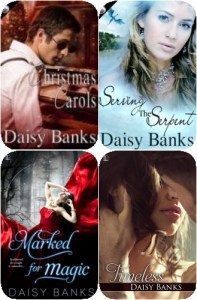
There are five free copies of each of these books available as prizes.
There is also a free read, Keep the Fire Burning, for all who would like it.
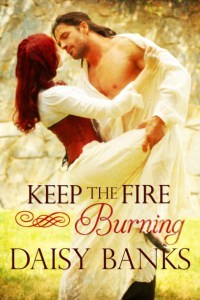
Keep the Fire Burning by Daisy Banks
Links to Mother’s Day Magic:
Amazon (international):
Working Link: http://www.mybook.to/MothersDayMagic
iTunes
USA: https://itunes.apple.com/us/book/id1077026791
UK: https://itunes.apple.com/gb/book/id1077026791
CAN: https://itunes.apple.com/ca/book/id1077026791
AUs: https://itunes.apple.com/au/book/id1077026791
NZL: https://itunes.apple.com/nz/book/id1077026791
Barnes and Noble
Nook: http://www.barnesandnoble.com/s/2940152738933
Kobo:
https://store.kobobooks.com/Search/Query?fcmedia=Book&query=9781524222727
And a reminder of all the writers participating in this anthology:

The fabulous line up of Mother’s Day Magic
Thanks so much to Tamara Ferguson for alerting me to this wonderful anthology, to Daisy Banks for being my guest today, and thanks to all mothers and to you all for reading. And remember, today it’s the first of April… Take it easy and have a laugh. And of course, like, share, comment and CLICK!
Author Translator Olga
En este blog hablo de la escritura y de mis libros, pero también reseño los libros de otros autores, comparto trucos, consejos, novedades literarias e ideas varias. Mi blog es bilingüe y comparto posts en español e inglés ...more
- Olga Núñez Miret's profile
- 250 followers



